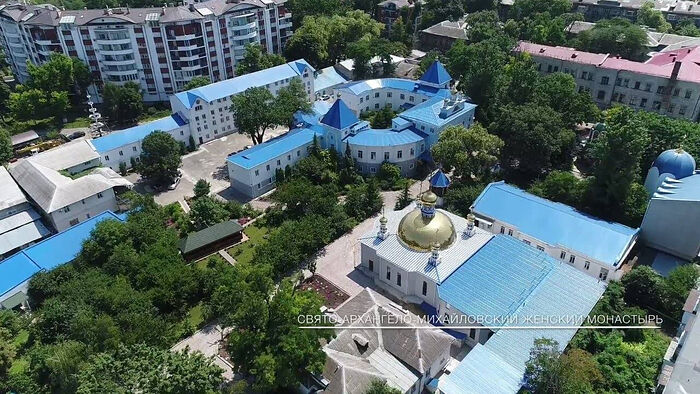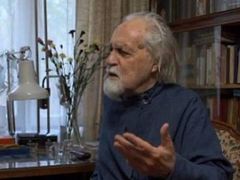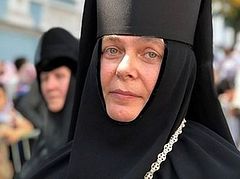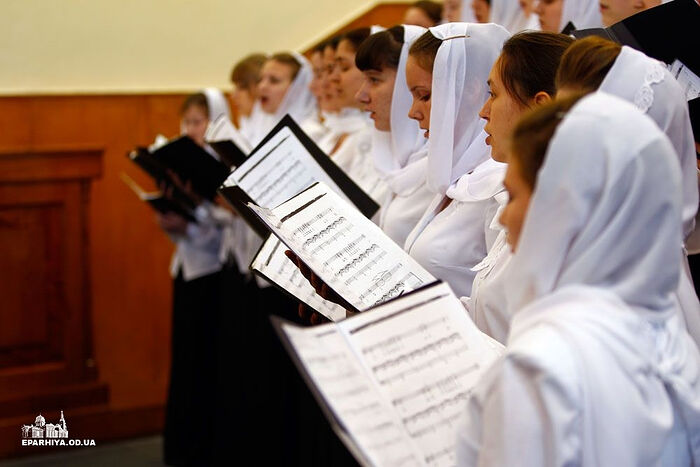 A group of students from the Choir Directors Department of the Odessa Theological Seminary
A group of students from the Choir Directors Department of the Odessa Theological Seminary
The Convent of the holy Archangel Michael in Odessa
In this article we will speak on one of the oldest theological schools in Ukraine—the Odessa Theological Seminary; to be more exact: about its departments where most students are young ladies—the Choir Directors Department, the Gold Embroidery Department, the Sewing Department, and the Icon-Painting Department. All of them are situated on the territory of the ancient Convent of the holy Archangel Michael, the revival of which began in 1992 through the labors of its indefatigable abbess, Mother Seraphima (Shevchik), and the sisterhood. The Odessa Seminary dates back to 1837, and the “educational establishment for daughters of the clergy” was established in 1844 on the territory of St. Michael’s Convent, which was founded on May 31 (according to the old calendar), 1841. The mission of the newly-revived convent includes the restoration of its educational, teaching and charitable traditions.
A little history
According to the archival sources of the “Christian Odessa” Museum, which has been built at the convent, initially in 1844 the convent was intended for educational and teaching activities. It was supposed to “maintain the students, provide funds for their tuition, by its way of life, manners and customs training exemplary Christian mothers and the spouses of future parish priests.”
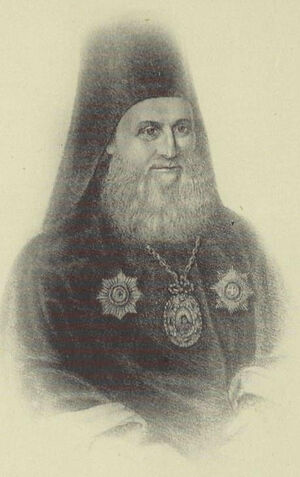 Archbishop Gabriel (Rozanov; +1858), Russian historian and the first historiographer of Ekaterinoslav and Novorossiya At that time it was the only educational establishment of that type not only in Novorossiya [a historical term denoting a region north of the Black Sea in the Russian Empire, comprising most of what is now Ukraine.—Trans.] but also in the whole of the Russian Empire. Among the founders of the convent and the school for girls were Archbishop Gabriel (Rozanov; †1858) of Kherson and Taurida; an outstanding diplomat and theologian, Alexandru Skarlatovich Stourdza (†1854); his sister Roxandra Skarlatovna Edling-Stourdza (1786–1844), Empress Consort Elizabeth Alexeyevna’s [the wife of Emperor Alexander I.—Trans.] favorite lady-in-waiting; Ivan Ilyich Rostovtsev, a First Guild merchant from Odessa, and many others. Among the major benefactors of the convent and its school, Empress Consort Alexandra Feodorovna [Emperor Nicholas I’s wife.—Trans.]; Tsarevich Alexander Nikolaevich [the future Emperor Alexander II.—Trans.]; the righteous Countess Anna Orlova-Chesmenskaya; and Princess Elena Ghica are worth mentioning. Besides, at least 10,000 rubles were received from the clergy of the Diocese of Kherson for these purposes. At first the school was called “an educational establishment for orphans.”
Archbishop Gabriel (Rozanov; +1858), Russian historian and the first historiographer of Ekaterinoslav and Novorossiya At that time it was the only educational establishment of that type not only in Novorossiya [a historical term denoting a region north of the Black Sea in the Russian Empire, comprising most of what is now Ukraine.—Trans.] but also in the whole of the Russian Empire. Among the founders of the convent and the school for girls were Archbishop Gabriel (Rozanov; †1858) of Kherson and Taurida; an outstanding diplomat and theologian, Alexandru Skarlatovich Stourdza (†1854); his sister Roxandra Skarlatovna Edling-Stourdza (1786–1844), Empress Consort Elizabeth Alexeyevna’s [the wife of Emperor Alexander I.—Trans.] favorite lady-in-waiting; Ivan Ilyich Rostovtsev, a First Guild merchant from Odessa, and many others. Among the major benefactors of the convent and its school, Empress Consort Alexandra Feodorovna [Emperor Nicholas I’s wife.—Trans.]; Tsarevich Alexander Nikolaevich [the future Emperor Alexander II.—Trans.]; the righteous Countess Anna Orlova-Chesmenskaya; and Princess Elena Ghica are worth mentioning. Besides, at least 10,000 rubles were received from the clergy of the Diocese of Kherson for these purposes. At first the school was called “an educational establishment for orphans.”
In 1871, with the blessing of Archbishop Dimitry (Muretov; +1883) of Kherson and Odessa, a detailed report was prepared by the institution’s board for the Diocesan Congress of Clergy. The Congress agreed with everything and ruled:
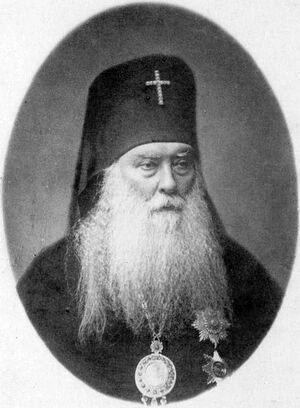 Archbishop Dimitry (Muretov; +1883) of Kherson and Odessa “To elevate the educational establishment for orphans to the rank of a school for girls and construct a new separate building within the convent walls for this purpose.”
Archbishop Dimitry (Muretov; +1883) of Kherson and Odessa “To elevate the educational establishment for orphans to the rank of a school for girls and construct a new separate building within the convent walls for this purpose.”
On the twenty-fourth day of October, 1873, the Building Committee was approved, with Archpriest Yakov Gavelya as chairman. Funds from the Most Holy Governing Synod’s Financial Administration were assigned to construct the school’s new building, designed by the diocesan architect Vasily Maas. The merchant A.F. Mavrokordato from Odessa made an enormous donation.
The foundation stone of the new school within the walls of St. Michael’s Convent was laid on April 22, 1875. The ceremony was headed by Archbishop Leonty (Lebedinsky; †1893) of Kherson and Odessa, the future Metropolitan of Moscow and Kolomna, who sprinkled the construction site with holy water and laid the foundation stone.
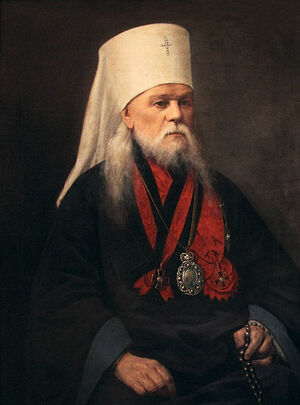 Archbishop Leonty (Lebedinsky; +1893) of Kherson and Odessa On the same day, by the supposed entrance to the new buildings at Uspenskaya Street, Archbishop Leonty, Mayor of Odessa Nikolai Novoselsky and other distinguished guests planted acacia trees, which still decorate this neighborhood of Odessa, filling it with the scent of spring. The school opened on August 16, 1878.
Archbishop Leonty (Lebedinsky; +1893) of Kherson and Odessa On the same day, by the supposed entrance to the new buildings at Uspenskaya Street, Archbishop Leonty, Mayor of Odessa Nikolai Novoselsky and other distinguished guests planted acacia trees, which still decorate this neighborhood of Odessa, filling it with the scent of spring. The school opened on August 16, 1878.
In the first school year, eighty-five students from among the former pupils of the educational establishment for orphans were admitted by passing the entrance exams. The innovative school building was spacious enough to accommodate over 200 students.
Retired Lieutenant Yegor Alexandrovich Leslie was elected as the churchwarden of St. Demetrius’ Church attached to the Diocesan School. In March 1889, he was succeeded by Nikolai Vasilievich Kataev, uncle of the famous Soviet playwright and novelist Valentin Petrovich Kataev [1897—1986; the author of the semi-autobiographical novel, A White Sail Gleams, etc.—Trans.]. And the writer’s father, Peter Vasilievich Kataev, taught in this school.
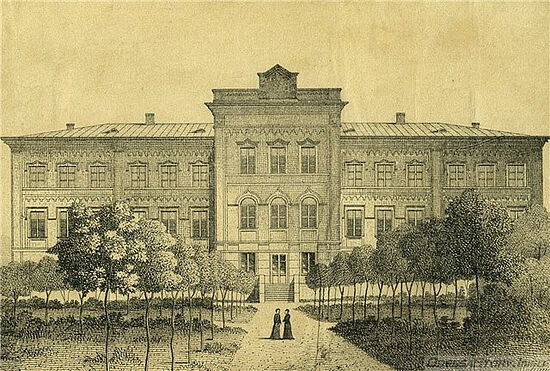 The Odessa Diocesan School for Girls. Engraving of the “Christian Odessa” Museum
The Odessa Diocesan School for Girls. Engraving of the “Christian Odessa” Museum
After the Russian Revolution the Odessa Diocesan School for Girls was placed under the authority of the Ministry of the People’s Education and reorganized as a gymnasium (a high school) for girls; some of its rooms were requisitioned as Red Cross sick quarters. The Decree on Separation of Church and State, adopted by the Council of People's Commissars of the Russian Soviet Federative Socialist Republic on February 2, 1918, came into effect in Odessa in 1921, after Soviet rule had been firmly established in the city. Icons were removed from all public buildings, and churches on the premises of all educational institutions were closed. In the next year the so-called “Children’s Park of the Social Education Department” appeared on the territory of St. Michael’s Convent. The building of the former Diocesan School for Girls was handed over to the Odessa People’s Education Committee and used as a detention center.
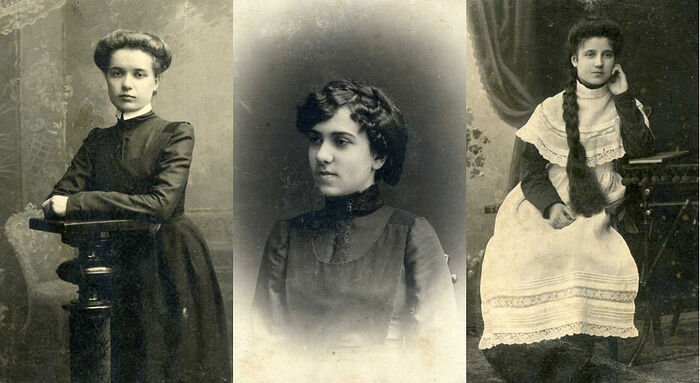 Students of the Diocesan School for Girls. Photo by the “Christian Odessa” Museum
Students of the Diocesan School for Girls. Photo by the “Christian Odessa” Museum
In 1924, a surveying and land improvement college opened there. From 1935, the building housed the Communist Kaganovich Higher School of Agriculture. After the Second World War, there was a dormitory within the walls of the Diocesan School for Girls.
Today
We learned these historical facts from the convent’s hospitable abbess, Mother Seraphima. An Odessa taxi driver who drove us to the convent on Uspenskaya Street on a warm September morning spoke of Abbess Seraphima with admiration in the slang so characteristic of Odessa: “Who doesn’t know her?! All of Odessa knows her! A classy woman!...”
To be more precise, this “classy woman” is known not only in Odessa but all over Ukraine. She is the author of over twenty books and monographs; in 2006, she was awarded an honorary title, the Best Christian Journalist, and a year later, in 2007, at the National Opera and Ballet Theater of Ukraine the title, “Woman of the Third Millennium”, was conferred on Abbess Seraphima by the State Commission. She is a member of the Inter-Council Presence of the Russian Orthodox Church and heads the UOC-MP’s Church and Culture Synodal Department. The abbess always speaks in a friendly and attentive manner with everybody.
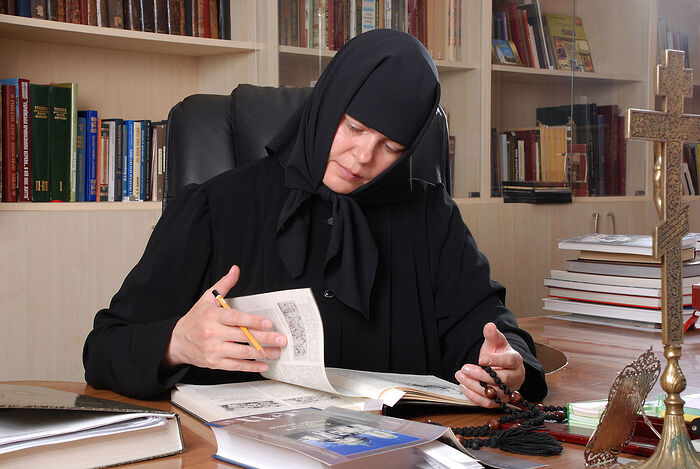 Abbess Seraphima (Shevchik) of the Convent of the holy Archangel Michael.
Abbess Seraphima (Shevchik) of the Convent of the holy Archangel Michael.
We talked with Mother Seraphima over sweet-smelling herbal tea in the spacious office which is simultaneously used as a storeroom of the “Christian Odessa” Museum. We had planned to ask her about the seminary departments on the territory of her convent, but the abbess forestalled us:
“This autumn we are marking the twentieth anniversary of the foundation of our theological school. It is the only seminary in Ukraine where female education is fully represented. While there are choir directors and icon-painting courses in other seminaries and theological schools, our students obtain a comprehensive education at four departments: those of choir directors, sewing, gold embroidery, and icon-painting. Besides, we are planning to organize courses that train and prepare nurses. With the blessing of Metropolitan Agafangel of Odessa and Izmayil we are considering this matter thoroughly: we are carrying on negotiations with medical institutions and educational establishments that train medical staff. We hope a medical department of this kind will open in the near future. I will mention in passing that at the convent we also have a home for the elderly and lonely sick people; medical staff look after senior members of our sisterhood there too (about 100 of them).
“All our undertakings, projects and initiatives are implemented with the blessing, participation and support of His Eminence Metropolitan Agafangel.
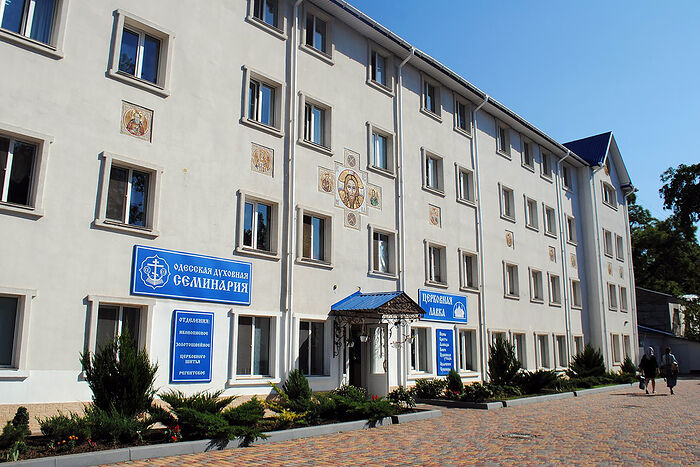 The building of the Odessa Theological Seminary at the Convent of the holy Archangel Michael.
The building of the Odessa Theological Seminary at the Convent of the holy Archangel Michael.
“The first department—that of choir directors—opened in 2000. The twentieth anniversary of the theological school for women is a happy occasion, since not everything was achieved with ease. The pre-revolutionary traditions were forgotten. In fact, in the mid-nineteenth century in the Russian Empire, modeled on the first school of Krasnoye Selo, around forty such institutions for daughters of the clergy were founded in all dioceses, in which ‘worthy spouses of the servants of the Divine altar and their helpers in the work of the moral and Christian education of parishioners’ were taught and educated. And that type of institution was very different from the secular ones, where girls were prepared for the brilliance of the life of ‘high society’ in the world. Concerned about its future, the Church understood that an institution where the spouses of future priests would be taught would be an extremely important sphere of Church influence on society.
“Our Museum has a unique monograph by its Director, Viktor Alexandrovich Mikhalchenko, dedicated to the clergy of Odessa beginning from 1794 (the year of the city’s foundation) up to 1925, which comprises 1,500 personalia and 500 illustrations. As you read priests’ biographies, you discover that the wives and daughters of virtually all the clergy studied at the Odessa Diocesan School in the mid-nineteenth century and afterwards married graduates of the Odessa Theological Seminary. We published this book in 2012, but the work is ongoing, because over these years a lot of information has been accumulated on immediate relatives of the priests and the New Martyrs; the author corresponds with many of them. So we are going to make a new edition.
“In 2000, on Archpriest Pavel Netsvetaev’s initiative and with our full consent, we decided to open choir directors’ courses for girls at our convent. First and foremost, we needed to prepare premises. In 1999, our four-storied ‘house of mercy’ was completed, and we accommodated our students on the top floor, providing them with classrooms and rooms to live in. Another task of ours was to form our teaching staff and develop a pedagogical system. In the first year we had very many students, as such specialists were in high demand in the Church. In twenty years we have graduated a collegiate of excellent choir directors, who have created professional Church choral ensembles that can be found even beyond the Diocese of Odessa. As we joke, thanks to our successful initiative many girls have since married priests and moved to all the parts of Ukraine and abroad (Russia, Moldova, Belarus, and beyond).
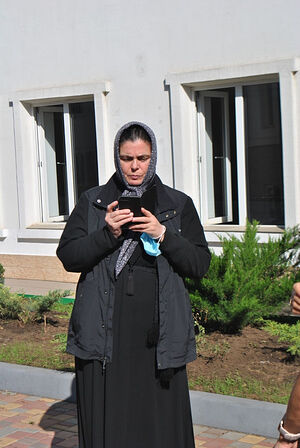 The phone interrupted our talk even there. “I should say that we don’t sever our contacts—we are friends, we still correspond. Looking back, I recall that not all our nuns were pleased with the presence of such neighbors at the convent. Many were indignant at seeing amorous couples hiding in the convent’s secluded nooks. But I explained to the nuns that they shouldn’t be upset, that all of us were tonsured of our own free will, that we must stand firm while keeping in mind that even in the nineteenth century there was a diocesan school for girls at the convent. We should take into consideration that most of our students will choose the path of family life. And we should rejoice because these girls will have strong Orthodox families and raise their children properly in the Church.”
The phone interrupted our talk even there. “I should say that we don’t sever our contacts—we are friends, we still correspond. Looking back, I recall that not all our nuns were pleased with the presence of such neighbors at the convent. Many were indignant at seeing amorous couples hiding in the convent’s secluded nooks. But I explained to the nuns that they shouldn’t be upset, that all of us were tonsured of our own free will, that we must stand firm while keeping in mind that even in the nineteenth century there was a diocesan school for girls at the convent. We should take into consideration that most of our students will choose the path of family life. And we should rejoice because these girls will have strong Orthodox families and raise their children properly in the Church.”
Mother Seraphima’s story was interrupted by phone calls time and again. She reacted to them with no worry, briefly giving orders and immediately returning to the subject. Then we went out into the yard, to the seminary’s entrance, but the phone interrupted our talk even there…
“Do you remember who earlier sang in our parishes?” the abbess proceeded. “Most of them were old women or secular people who were able to sing from a sheet of music but had no knowledge of the Typicon and could hardly read in Slavonic.
“Our students are taught the rudiments of theology, Church and Bible history, the Catechism. They graduate with a broad education and are deeply engaged in church, to say nothing of their rare and important specialties. Take gold embroidery as an example. Someone who is good at this craft is a godsend to any parish! Such a companion for life as one of our graduates will make a fine spouse and be an indispensable helper to a future priest, and a fount of knowledge and spirituality.
“Our girls also (optionally) study history of the development of Orthodoxy in Odessa and are actively helping us collect materials for the ‘Christian Odessa’ Museum.”
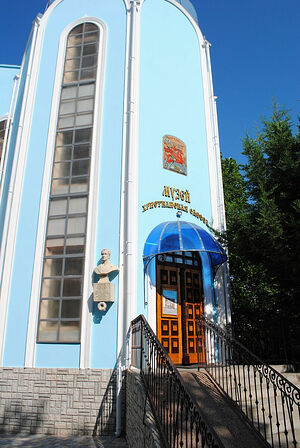 The “Christian Odessa” Museum on the territory of the convent In conclusion, we asked the abbess about the teachers of the women’s seminary.
The “Christian Odessa” Museum on the territory of the convent In conclusion, we asked the abbess about the teachers of the women’s seminary.
“Theological subjects are taught by teachers of the Odessa Theological Seminary and clergy of the Diocese of Odessa,” the abbess explained. “The core subjects are taught by specialists in their spheres who have a basic secular higher education and are aware of the importance of the subjects they teach at the same time. For this we invite highly qualified specialists: conservatory teachers, professors of the Pedagogical University [most probably South Ukrainian National Pedagogical University named after K.D. Ushynsky.—Trans.] and professional artists.
“Some teachers of the Icon-Painting Department worked on probation at the Holy Trinity-St. Sergius Lavra where the same department opened in the 1990s. Please, meet some of our graduates who now work as teachers and educators, and they’ll tell you everything themselves.”
And so we got acquainted with them.
Olga Mudraninets, twenty-three, graduate of the Gold Embroidery Department and tutor:
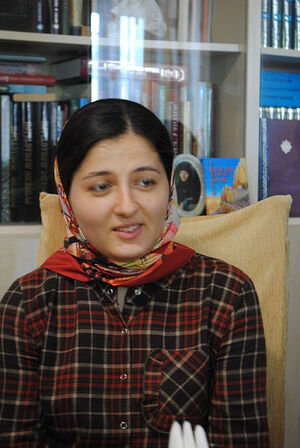 Olga Mudraninets “I came here from the Cherkassy region immediately after graduating from a village school. I grew up in a religious family and I have been a church-goer since childhood. My mother is an accountant, and my father is an electrician. It was my grandma who suggested that I go and study here. There used to be a popular SOS (Save Our Souls) magazine—perhaps it still exists. My grandma would read all its issues. And one day she came across an ad for female students to enroll in the Odessa Seminary’s sewing courses. At the time I had no idea that such institutions exist. I was uncertain about my future profession, but I was always fond of needlework, especially cross-stitch… After thinking and praying for a while, I went to our village church to take Fr. Michael’s advice. The priest gave me his blessing and I left for Odessa.
Olga Mudraninets “I came here from the Cherkassy region immediately after graduating from a village school. I grew up in a religious family and I have been a church-goer since childhood. My mother is an accountant, and my father is an electrician. It was my grandma who suggested that I go and study here. There used to be a popular SOS (Save Our Souls) magazine—perhaps it still exists. My grandma would read all its issues. And one day she came across an ad for female students to enroll in the Odessa Seminary’s sewing courses. At the time I had no idea that such institutions exist. I was uncertain about my future profession, but I was always fond of needlework, especially cross-stitch… After thinking and praying for a while, I went to our village church to take Fr. Michael’s advice. The priest gave me his blessing and I left for Odessa.
“After a successful interview I was admitted. Initially it was rather hard. There are certain rules at seminary to follow: the morning and the evening prayers, classes according to schedule, compliance with the daily timetable and discipline. But then I adapted to this system and came to love the convent and its seminary, my friends and teachers here. After completing my studies at the Department of Gold Embroidery I was offered the job of a tutor here. And now, combining work as a tutor and an embroideress in gold, I’ve decided to study icon-painting at the same time…”
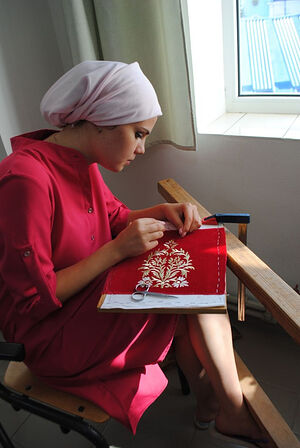 At the gold embroidery workshop. While visiting the Gold Embroidery Department classes, we asked Olga about her impressions five years ago when she had just arrived here.
At the gold embroidery workshop. While visiting the Gold Embroidery Department classes, we asked Olga about her impressions five years ago when she had just arrived here.
“When I came here, I found myself in a completely different world. I know it sounds sentimental, but it was like being in a fairy-tale. I couldn’t have imagined that I would be able to choose a profession that would bring me so much happiness and joy. Embroidering is like working a little miracle, ‘playing’ with gold, silver threads and beads, seeing for yourself that you are doing an important and useful work. Before that I didn’t know that the artist’s role in this world is so important! I am happy that the Lord has brought me here.
“Apart from mastering gold embroidery, I have learned so much about our faith, the Church, the saints, and the Gospel has been revealed to me… Now I understand that a believer can explain everything.... For example, there are no coincidences in one’s life; rather, everything happens by Divine Providence for a particular reason. I have met very interesting people here, and I have learned or am still learning something from each of them. I admire many of them and follow their example. After spending these years at the convent and remembering myself after school, I understand what a beautiful path the Lord has opened up before me…”
Alexandra Tsapenko, nineteen, a third-year student of the Choir Directors Department:
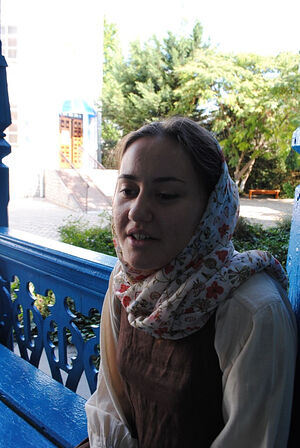 Alexandra Tsapenko. “In childhood, my granny would take my brother and me to church to Sunday services and for Communion. Later school began, and church was ‘pushed to the sidelines’. But when I was between eleven and thirteen, our family started to actively integrate into Church life and the church became a second home for us. I finished school. The uncertainty of the future scared me. However, I lived in expectation, feeling that something would happen… And I prayed. I was not alone: all my family, along with the women with whom I used to sing in the choir, prayed with me. At some point my grandma suggested that I try courses for choir directors. And the choir director of our church was Anna, who had graduated from the Odessa Seminary! She gave a call to the admissions committee and inquired about the requirements to enter seminary. Applicants for admission were required to know Bible history well, read in Church Slavonic, and sing some Church hymn. With the blessing of our priest, Fr. Vasily, I started preparing and later travelled to seminary with my mom to take the exams. Of course, I worried a lot…
Alexandra Tsapenko. “In childhood, my granny would take my brother and me to church to Sunday services and for Communion. Later school began, and church was ‘pushed to the sidelines’. But when I was between eleven and thirteen, our family started to actively integrate into Church life and the church became a second home for us. I finished school. The uncertainty of the future scared me. However, I lived in expectation, feeling that something would happen… And I prayed. I was not alone: all my family, along with the women with whom I used to sing in the choir, prayed with me. At some point my grandma suggested that I try courses for choir directors. And the choir director of our church was Anna, who had graduated from the Odessa Seminary! She gave a call to the admissions committee and inquired about the requirements to enter seminary. Applicants for admission were required to know Bible history well, read in Church Slavonic, and sing some Church hymn. With the blessing of our priest, Fr. Vasily, I started preparing and later travelled to seminary with my mom to take the exams. Of course, I worried a lot…
“I wasn’t afraid of the audition because I had studied at a music school for eight years. And after singing ‘O Theotokos and Virgin, Rejoice!’, by the silence in the room I understood that they were pleased; they didn’t even asked me any theoretical questions…
“I found the first year difficult. I had to get used to the daily timetable and discipline. But in my second year I was convinced that I had made the right choice and that I liked everything here. Whenever I leave for a while and then come back, I liven up at the convent. I say to my acquaintances, ‘This place gives me energy! The grace of God reigns here!’ I don’t think much about the future. I feel everything will happen by the will of God (like my admission), when I myself come to understand what I need.
“I left behind many non-religious friends at home. I didn’t conceal my choice from them and I still keep in touch with them. I hope one day they will convert, and the world will expand its horizons to them, and their lives will be filled with a new meaning.”
Olga Kiriy, thirty-seven, tutor-supervisor:
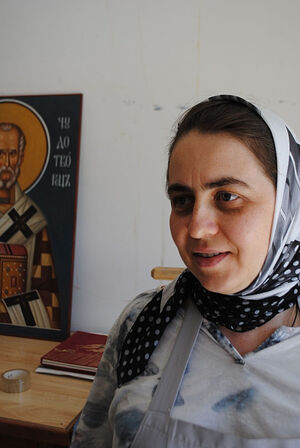 Olga Kiriy. “I work with mosaics, do mural painting and sing in the choir. My position at seminary is tutor-supervisor of the Department of Painting, and the mother-superior jokingly calls me ‘the back office manager’ (laughs). My duties include seeing to student discipline, observance of the daily timetable, responsibility for cleanliness and order in the classrooms and the living quarters and all household matters… After all, we have workshops, mosaics, painting classes… For three years I studied painting in seminary, and I decided to devote this fourth year to mosaics, mural painting and developing skills in icon-painting. I already work as an independent iconographer; my works can be founded at our St. Michael’s Church. The church of the Dormition Monastery of Odessa has my icon of the Ascension of the Lord, and with the blessing of Mother Seraphima I take other orders, too. And I am still mastering skills in mosaics and mural painting. I am finishing a hagiographical icon of the Hodegetria Mother of God of Smolensk; I’ve been working on it for the second year.”
Olga Kiriy. “I work with mosaics, do mural painting and sing in the choir. My position at seminary is tutor-supervisor of the Department of Painting, and the mother-superior jokingly calls me ‘the back office manager’ (laughs). My duties include seeing to student discipline, observance of the daily timetable, responsibility for cleanliness and order in the classrooms and the living quarters and all household matters… After all, we have workshops, mosaics, painting classes… For three years I studied painting in seminary, and I decided to devote this fourth year to mosaics, mural painting and developing skills in icon-painting. I already work as an independent iconographer; my works can be founded at our St. Michael’s Church. The church of the Dormition Monastery of Odessa has my icon of the Ascension of the Lord, and with the blessing of Mother Seraphima I take other orders, too. And I am still mastering skills in mosaics and mural painting. I am finishing a hagiographical icon of the Hodegetria Mother of God of Smolensk; I’ve been working on it for the second year.”
We asked Olga to tell us how she had ended up at the Odessa Seminary.
“I was born in Lugansk. Now there is war there. My parents are still there. I am often asked how we survived the beginning of the hostilities. And I answer: with the help of God. My father, Archpriest Alexander, stayed there when the city was shelled and he still serves there. And I ended up here in a miraculous way. When my sister married, she and her husband went to Odessa for two weeks to spend their honeymoon here. But on the next day the war broke out. So they stayed here in Odessa… My mother and I were sent on a leave of absence because the enterprise in Odessa no longer worked due to war. And we travelled here to Odessa to bring some things to the newlyweds: they had left for Odessa for a fortnight but would have to stay there for an undetermined time. It was on July 21, 2014—the feast of the Kazan icon of the Theotokos! Thus the Mother of God brought us here.
“I remember our train standing at the station of the town of Yasinovataya. Ten minutes after our departure, air raids on the station began… Thus the Queen of Heaven saved us… When we arrived in Odessa, we learned that all the roads had been blocked, so there was no way we could go home …
“We couldn’t contact dad because of the war. Local people suggested that we turn to Fr. Vasily, a good priest in Odessa. Trying to reassure us, Fr. Vasily said, ‘Today you’ll receive the news that your daddy is safe and sound.’ And his words came true: on the same day we heard from our fellow-townsmen that my dad was fine.
“What to do next? We started searching for jobs. Without work record cards, with only our passports in our hands, our chances were slim. My sister was employed as a tutor at a private kindergarten, and I got a job as a nanny there. However, we worked there for less than a week: the kindergarten administration wasn’t pleased that we were religious and wore crosses around our necks. Then I realized that it was Divine Providence in action. We were fired. I wasn’t really upset because only iconography school was on my mind. I had tried to paint icons before that, though I had never studied icon-painting. My desire was so strong that it seemed I would die if I didn’t find such a school In Odessa! I googled it, and the first thing I found was the link to the website of the seminary at St. Michael’s Convent with its department of icon-painting. I was happy and gave thanks to God! I wasn’t sure I would be able to join it, though. But nevertheless…
“Three days before the exams I called and inquired about the requirements for admission. And I passed them! Therefore, if I hadn’t been laid off so early, I wouldn’t have entered seminary in 2014. Thus the Theotokos helped me…
“When the roads reopened, my mother returned to Lugansk. Of course, my heart ached for my family in Lugansk, my native city. I was seeing young people’s happy faces in Odessa, but my heart was breaking… After all, our city was shelled, churches and a monastery [most probably the Convent of the Holy Royal Martyr Olga.—Trans.] were damaged.
“But then I felt more relieved. Faith in God’s help, my father’s prayers, and the intercession of the Mother of God gave me strength… Now there is a lull. We hope and pray that long-awaited peace will be achieved…”
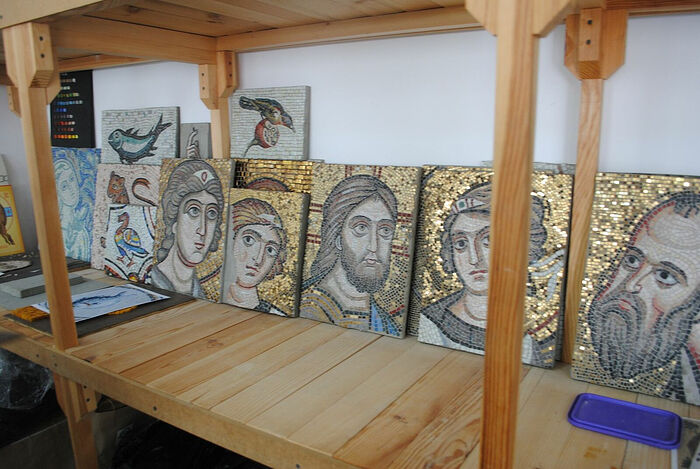 The seminarians’ mosaic works.
The seminarians’ mosaic works.
***
Our trip to Odessa was over. Saying good-bye to the convent, Mother Seraphima, the seminary’s amazing teachers, and the students, we took with us the warmth of this southern city, the gentle sea and the unforgettable impressions we had obtained there.

